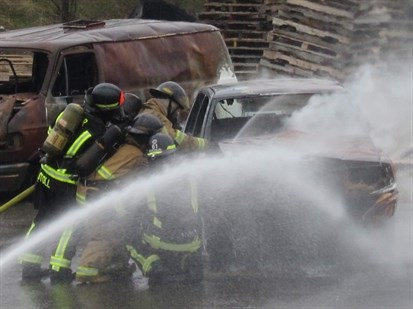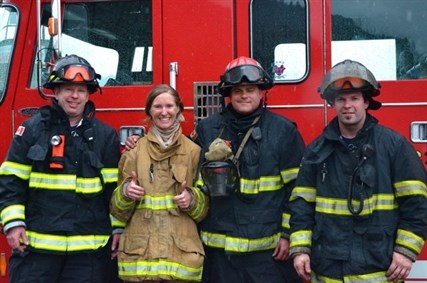
Charlotte Helston at the front line, helping put out a car fire.
Image Credit: Courtenay Pitcher/ City of Vernon
April 15, 2013 - 9:33 AM
"It's like walking into a house you've never been in before, in the dark."
I'm kneeling in the corner of a small concrete room, watching as flames blossom on the opposite side of the room, and becoming acutely aware that all the doors and windows have been sealed shut.
I'm here voluntarily, learning what it's like to be a Vernon firefighter. We're at a training facility on the outskirts of the city, and though the flames are real—and dangerous—they're only part of a demo. The crew jokes they haven't lost anyone—yet.
I look the part, sort of. I've got the proper pants, suspenders, jacket, and an oxygen tank strapped to my back. My face mask makes me look like an alien out of the old Star Wars movies. Altogether, the gear weighs around 50 lbs—nearly half my total body weight. I don't have the stature of the all-male crew around me, or the big feet. Mine are swimming in gumboots a few sizes too big, making it impossible to move quickly—or run.
Inside my human oven-mit costume, my heart is thumping. Jack Blair, Vernon deputy fire chief, is the host of this burning building. I watch as he aims a blow-torch at three flaming wooden pallets, feeding the inferno.
By now, it's getting hot. Around 900 F. "A million degrees" doesn't even come close to describing the suffocating heat. I notice some of the firefighters are laying down, casually, as if on towels at the beach. I crouch closer to the floor, and realize it's much cooler.
Blair yells something, but I can't hear—my Darth Vader breathing is too loud inside my air bubble. I hear a whoosh as water is released from the hose, and when it hits the fire, everything goes dark.
I reach out to feel the ground, and the smoke is so thick, I can't see my hand. These are typical conditions faced by firefighters when they arrive on scene. Contrary to what I had thought, a burning building is not illuminated by bright flames.
"It's like walking into a house you've never been in before, in the dark," Blair says.
Blinded by smoke, firefighters have to rely on their other senses to guide them. They use their sense of hearing to listen for the fire, and each other. Aside from feeling their way around—up stairs, through rooms—the sense of touch allows them to feel where the heat is coming from. If they can't see or hear well, firefighters will place a hand on each other's shoulders to stay together.
Blair says the rule is to always have communication with your partner via one of the three: sight, touch or hearing. The buddy system has saved his life more than once, including a time he stepped into a burned out hole but was caught by his partner.
I take a deep breath. I can't see anything. My ears, shielded by a cotton balaclava, burn. My eyes water. I pump oxygen into my mask to get rid of the foggy film. It's still dark as night, but then someone opens a window and everything turns grey.
Blair blasts water out through the window and you can see smoke rapidly travelling out into the daylight. It reminds me of watching clouds race through the sky on a windy day, though without all the fresh air.
Flushing out smoke is the crew's number one priority because the stuff is highly combustible. Fighting fires is as much about fighting smoke. It's not about getting in and spraying water right at the fire. There's a method to follow, and it's keenly conducted by science. It's a give and take of creating positive pressure, pushing out smoke, watering the fire, which feeds on the air venting in from the open window, and repeating the process until the fire's out.
Blair talks about flashover—the moment it gets so hot everything ignites.
"That's somewhere between 900 and 1,100 F," Blair says. "At that temperature, in our gear, we'd only last five minutes."
About ten minutes later, the fire is snuffed out. Firefighters rarely work in these conditions: a concrete room with nothing to catch fire except for three wooden pallets. Usually, there's carpeting, couches, tables, and it all goes up like parchment. Firefighters might be battling flames for days in these situations.
I'm just catching my breath when I'm told there's another fire upstairs. My buddy, Capt. Dan Walker, checks my gear over, making sure not a trace of hair is sticking out, or a section of skin exposed.
"This fire will be a bit more challenging," he says. I can't see his face very well beneath his mask, but I can tell from his tone he's smiling.
I can't see anything as we feel our way up the stairs with a bulky hose in our hands. As we climb, the heat builds. We reach a landing halfway up, and flames are rolling over the ceiling.
We get down low, and crawl the last few steps. On hands and knees, we shuffle up to the fire. The rumble is overwhelmingly loud.
"You're going to put it out," Walker says, handing me the nozzle. We're about a meter away from the fire, embers are raining overhead, and I feel like I'm about to faint.
I grasp the hose firmly in my left hand, and prepare to pull the trigger.
"Point it right down low, at the base of the fire," Walker says.
I take aim and heave back on the lever. The power jolts me back and the hose bucks uncontrollably. Together with Walker and the rest of the crew, we steady the hose and hold it straight. When it gets smoky, I spray water out the open window, and clouds of combustibles whip outside.
This fire, and our plan of attack, mimic a recent blaze at an apartment building in Vernon.
"These training sessions are essential," Walker says. "This is our playground, and we sure have fun, but it also gives us confidence when we're out facing the unknown. You never know what's inside when you get to a fire."
It's raining when we get back outside. I pull off my helmet, mask and balaclava and let the air and water hit my skin. It feels absolutely glorious.
I chat with the crew, and learn most of them have been firefighting for around 20 years. For many, it's in their blood.
"My dad was a fireman," Blair says. "When I was 12 years old, he told me, 'Kid, firefighting is the best goddam job in the world."
Blair, and the rest of the Vernon firefighters, couldn't agree more. Actual firefighting is really just a small part of their job. They're often the first responders to car crashes and other accidents.
Wherever they are, their mantra is the same.
"At the end of the day, we all want to come home," Walker says.
As deputy fire chief, Blair takes it a step further. "I want them to come home healthy, without lung problems or anything else. Safety is paramount these days. It's not about charging in because it's an exhilarating job. Only fools rush in."
I add my uniform to the pile of sooty, sweaty, filthy gear and rub my aching shoulders. My two hours posing as a firefighter are over. The team parts ways for the day, each firefighter heading safely home to life beyond the flames.
To contact the reporter for this story, email Charlotte Helston at chelston@infotelnews.ca or call (250)309-5230.

Charlotte Helston geared up, nervous, but ready to go.
Image Credit: Courtenay Pitcher/ City of Vernon

Reporter Charlotte Helston at the Vernon training facility, still in one piece after helping extinguish four fires.
Image Credit: Contributed
News from © iNFOnews, 2013